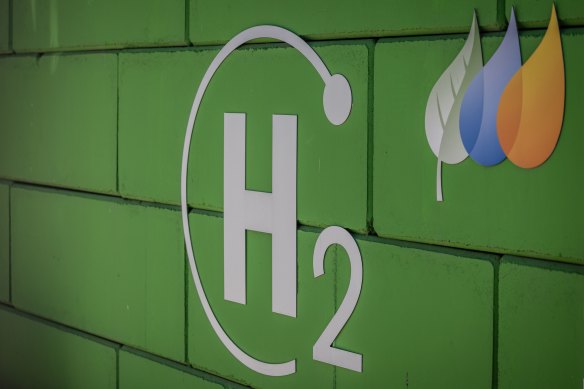Save articles for later
Add articles to your saved list and come back to them any time.
The carbon price imposed on big polluters must nearly double to make the Albanese government’s hydrogen dream a reality, experts say, opening a new debate over the cost of transforming Australia from a fossil fuel powerhouse into a green energy superpower.
Climate Change and Energy Minister Chris Bowen is attending the United Nations annual climate summit COP28, in Dubai, to spruik Australia’s climate credentials and gain support for the Albanese government’s election promise to host the meeting in three years’ time.
The Grattan Institute says Australia must raise the price big polluters pay for their emissions if hydrogen is to replace fossil fuels. Credit: Bloomberg
Australia is the third-largest fossil fuel exporter in the world, and Bowen said on Sunday that the government’s landmark $2 billion Hydrogen Headstart program was backing large-scale projects to turn the nation into a globally significant supplier of green energy.
The Grattan Institute’s Hydrogen: hype, hope, or hard work? report said the government’s current carbon price, which is imposed by its safeguard mechanism policy, is too low to encourage big polluters to switch from relatively cheap fossil fuels to more expensive hydrogen.
The think tank backed the government’s strategy to increase demand for hydrogen in Australia’s iron, alumina and fertiliser factories before scaling up production for global exports.
But it found the government’s current carbon price is too low to encourage big polluters to switch from relatively cheap fossil fuels to more expensive hydrogen.
Grattan Institute climate change and energy program director Tony Wood said the $75 a tonne carbon price under the Safeguard Mechanism would have to at least rise to match the European Union’s price, which is currently trading at $130 a tonne.
Hydrogen burns cleanly and emits only water vapour, which is why governments around the world are investing hundreds of billions of dollars in hydrogen technology.
The federal government’s Hydrogen Headstart program will only invest in hydrogen produced with renewable energy and rules out the use of gas and carbon capture technology.
It is aiming to bring down the cost of hydrogen production so it can compete with fossil fuels for heating, electricity generation, transport and manufacturing processes.
The Safeguard Mechanism forces 215 of the biggest industrial polluters – such as smelters, steelmakers and fertiliser producers – to cut their greenhouse emissions by 4.9 per cent a year.
If the companies exceed their pollution limits they must buy offsets, which the government has capped at $75 a tonne to protect against potential price shocks.
“The incentive to switch to green hydrogen depends on the price of carbon,” the Grattan Institute’s report says. “If the price of carbon is low, the incentive to switch to green hydrogen is weakened.”
The government will review the safeguard mechanism settings in 2026.
A spokesperson for Minister Bowen said hydrogen was crucial to cut pollution in heavy industry.
“Hydrogen is key to achieving net zero, especially in industrial sectors, and for unlocking Australia’s renewable superpower opportunities including green metals, green manufacturing and clean energy export,” the spokesperson said.
Hydrogen can replace natural gas in alumina refining to generate high-temperature heat for calcination.
It can also be mixed with nitrogen to create ammonia, a key component of fertiliser and explosives. Using green hydrogen to produce ammonia can decarbonise the traditional process.
Hydrogen can produce low-emissions iron in a process called direct reduction, replacing the traditional high-emissions production that uses coal in a blast furnace.
Cut through the noise of federal politics with news, views and expert analysis. Subscribers can sign up to our weekly Inside Politics newsletter.
Most Viewed in Politics
From our partners
Source: Read Full Article
